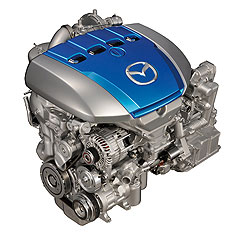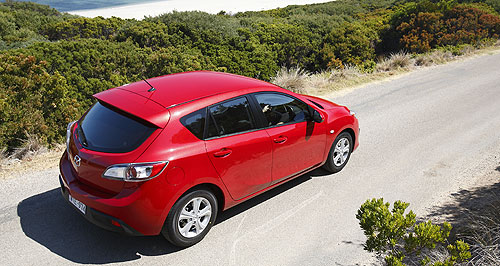Future models - Mazda - Mazda3 - DieselMazda3 Diesel decision loomsDiesel dance: Mazda is mulling plans to introduce a diesel Mazda3. Early 2010 launch on the cards as Mazda Australia ponders diesel-powered small car15 Oct 2009 MAZDA is continuing its diesel engine push and could have a Mazda3 Diesel on the Australian market as soon as early 2010. According to Mazda Australia national marketing manager Alastair Doak, the engineering work has already been done, as part of the latest generation’s introduction to Australia in April this year. Mr Doak said a new business case was being assembled and a decision would be made at the end of this month. “We wanted it from day one, but it didn’t weigh up (at the time),” said Mr Doak, who added that Mazda was keen to build up its diesel portfolio, something other Japanese manufacturers are not doing. Mazda’s local diesel ambitions are being restrained by the lack of automatic transmissions, a factor that will weigh heavily for female-dominated Mazda3 buyers, as it will do for the new CX-7 Diesel launched this week. Automatic transmissions for the diesels were not produced because they were not required for Europe, which is Mazda’s main diesel market, but are now being developed in Japan and will start coming through to the Australian market in two or three years.  Left: Mazda's next-generation SKY-D diesel engine. Left: Mazda's next-generation SKY-D diesel engine.Mazda Australia managing director Doug Dickson said it became more difficult to make a case for diesel because the inherent extra cost was the same for a small car as a large SUV, making it a proportionately bigger impost on the cheaper car. “The further down the train you get, the more difficult it becomes to make it a value equation because there is a diesel premium and it’s the same basically if you are in a Mazda2 or a CX-7, so the value equation becomes harder to justify the further down you go,” Mr Dickson told GoAuto. “We’re still interested, though, because I think diesel is going to be a significant part of what we do with the new-generation powertrains. “Our next generation powertrains are going to focus on improving the existing technology (as we move) towards a 30 per cent reduction in fuel usage by 2015. A lot of that’s going to be diesel. A lot of it’s going to be petrol, too, but we believe that diesel is going to be a significant part of the way things are done down the track. “The fact we don’t have automatics is an issue right now, but won’t stop us from introducing them. There are certainly buyers out there who appreciate them that are buying them. “We’ve accessed the things that we can access and down the track we think we’d do a full range of products in the diesel area.” Of the Japanese manufacturers, Mazda seems to be pushing diesel the hardest and seems to be investing in electric cars and hybrids mainly for marketing reasons and to be seen to be following the environmental trend. Mr Dickson said electrics and hybrids would still be a significant part of the company’s mix, but said that existing liquid fuel technology “is going to probably be a more important part of our strategy”. He said the more efficient SKY four-cylinder diesel and petrol engines and SKY-Drive automatic transmission about to be unveiled at the Tokyo motor show would not come to Australia before 2012. As GoAuto has previously reported, Mazda Australia is assessing Thai production sourcing for its Mazda2 hatch and Mr Dickson described the main discussions over the main issues of capacity and price as “sensitive”. Although Australia has a free-trade agreement with Thailand, he said that duty was not a determining factor because many of the components still came from Japan, which complicated the issue of exchange rates as well. “The Thai baht is not the most stable currency around, so sometimes you get some difficulty with prices,” he told us. “The Japanese manufacturers started in Thailand because predictions at the time were that the Thai market itself would be a massive market. It didn’t end up that way because of the Asian financial crisis and a few other things, so it has been used as a hub for export. But it’s principally there to support the Thai market, so they get first preference. So it’s not a lay-down misere by any stretch of the imagination.” Mr Dickson also said that Mazda Australia was still interested in the unique Mazda2 sedan built in China. “We’re very impressed with that,” he said. “That’s one we’re looking at, but there’s nothing to report at this moment. “We’ve never had a little sedan in the Light segment, but it looks good and certainly there’s some downsizing going on (in Australia) – the Small segment appears to be getting the majority of it, but the Light segment’s still pretty good. “When I first saw it some years ago, I thought, ‘That’s not a bad little jigger, we’ll see what we can do to get hold of that’.”  All future models Alfa Romeo Alfa Romeo Abarth Abarth Audi Audi Aston Martin Aston Martin BMW BMW Bentley Bentley Chrysler Chrysler Chevrolet Chevrolet Dodge Dodge Citroen Citroen Ferrari Ferrari DS DS Ford Ford Fiat Fiat FPV FPV Foton Foton Haval Haval Great Wall Great Wall Honda Honda Holden Holden Hyundai Hyundai HSV HSV Isuzu Isuzu Infiniti Infiniti Jeep Jeep Jaguar Jaguar Lamborghini Lamborghini Kia Kia Lexus Lexus Land Rover Land Rover Mazda Mazda Maserati Maserati Mercedes-Benz Mercedes-Benz McLaren McLaren Mini Mini Nissan Nissan Mitsubishi Mitsubishi Peugeot Peugeot Opel Opel Proton Proton Porsche Porsche Renault Renault Ram Ram Saab Saab Rolls-Royce Rolls-Royce Smart Smart Skoda Skoda Subaru Subaru SsangYong SsangYong Tesla Tesla Suzuki Suzuki Toyota Toyota Volvo VolvoMazda3 pricing
Motor industry news |
Click to shareMazda modelsResearch Mazda All future models Alfa Romeo Alfa Romeo Abarth Abarth Audi Audi Aston Martin Aston Martin BMW BMW Bentley Bentley Chrysler Chrysler Chevrolet Chevrolet Dodge Dodge Citroen Citroen Ferrari Ferrari DS DS Ford Ford Fiat Fiat FPV FPV Foton Foton Haval Haval Great Wall Great Wall Honda Honda Holden Holden Hyundai Hyundai HSV HSV Isuzu Isuzu Infiniti Infiniti Jeep Jeep Jaguar Jaguar Lamborghini Lamborghini Kia Kia Lexus Lexus Land Rover Land Rover Mazda Mazda Maserati Maserati Mercedes-Benz Mercedes-Benz McLaren McLaren Mini Mini Nissan Nissan Mitsubishi Mitsubishi Peugeot Peugeot Opel Opel Proton Proton Porsche Porsche Renault Renault Ram Ram Saab Saab Rolls-Royce Rolls-Royce Smart Smart Skoda Skoda Subaru Subaru SsangYong SsangYong Tesla Tesla Suzuki Suzuki Toyota Toyota Volvo VolvoMazda3 pricing
Motor industry news |














Facebook Twitter Instagram